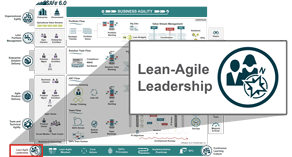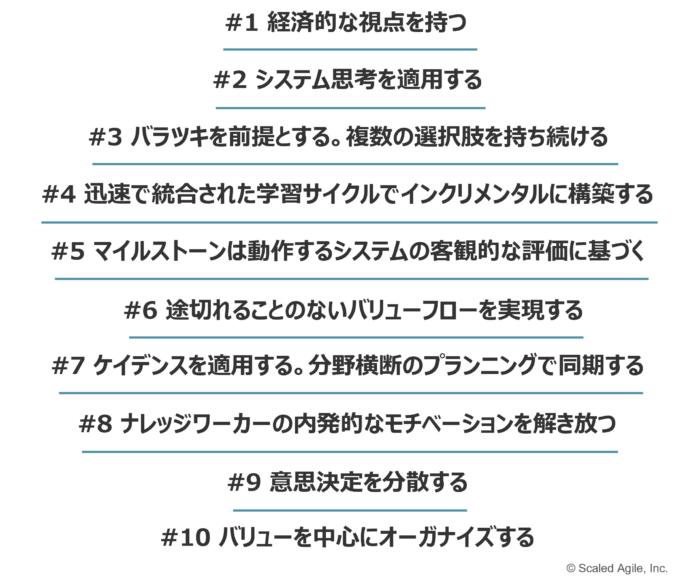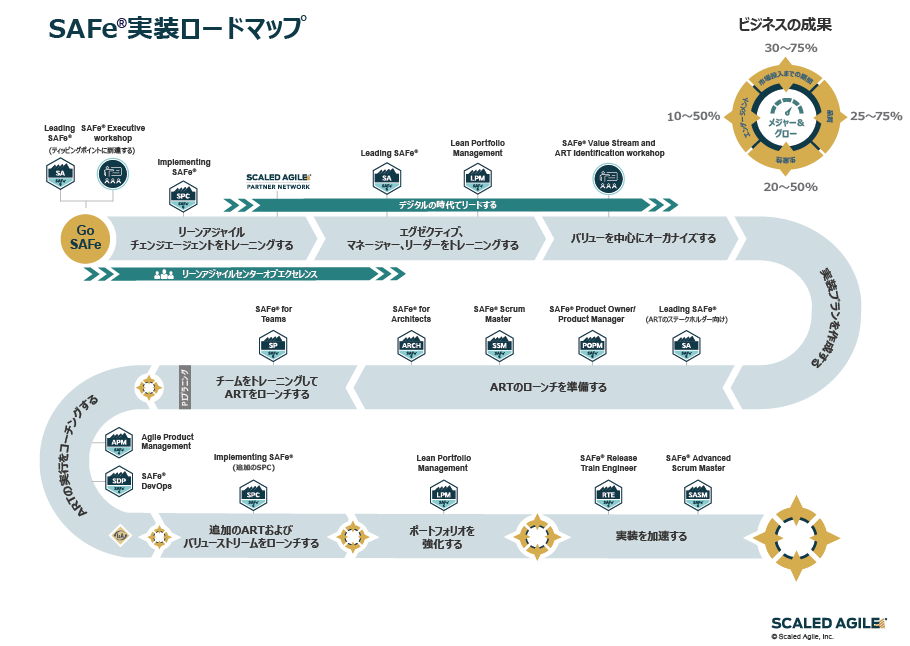
It’s not enough that management commit themselves to quality and productivity, they must know what it is they must do. Such a responsibility cannot be delegated.
—W. Edwards Deming
Paraphrased from Out of the Crisis [1]
リーンアジャイルリーダーシップ
概要
学習を始めますか?
検索ツールを使用して現在の提供内容を探索するか、特定のコースについて詳しく学びましょう。
定義: リーンアジャイルリーダーシップ (LAL) のコンピテンシーは、リーダーが個人やチームが潜在能力を最大限発揮できるよう権限を与えることにより組織の変化やオペレーショナルエクセレンスを推進、維持する方法を説明します。
リーンアジャイルリーダーは、手本を示し、SAFeのリーンアジャイルマインドセット、バリュー、原則、実践を学んでその模範となり、新しい働き方への変革をリードすることでこれを実現します。
リーンアジャイルリーダーシップは、ビジネスアジリティの7つのコアコンピテンシーの1つであり、コアコンピテンシーはどれもビジネスアジリティの達成に不可欠です。 コアコンピテンシーごとに固有のアセスメントが用意されていて、企業はこのアセスメントを通じて自社の習熟度を評価できます。 メジャー&グローの記事では、こうしたコアコンピテンシーアセスメントと推奨される改善機会を取り上げています。
なぜリーンアジャイルリーダーなのか
組織のマネージャーやエグゼクティブをはじめとするリーダーには、ビジネスアジリティの実現につながるリーンアジャイル開発とコンピテンシーを導入し、成功させ、継続的に改善する責任があります。仕事の進め方を統制するシステムを変革し、絶えず改善する権限をもつのはこうしたリーダーだけです。また、ハイパフォーマンスアジャイルチームが活躍し、バリューを生み出す環境を創出できるのもこうしたリーダーたちです。したがって、リーダーは、よりリーンな思考と業務運営を習得して自ら模範となり、手本やコーチング、激励を通じてチームメンバーが学べるようにする必要があります。
企業全体でアジリティを達成することは、単純でも簡単でもありません。 以下に述べるように、ビジネスアジリティの実現にはリーダーシップに対する新たなアプローチが必要です。それはまず、リーダーが行動で手本を示し、組織がより良い働き方を追求するためのインスピレーションやモチベーションを高めることから始まります。手本を示すにあたっては、リーンアジャイル原則と実践を通じて個々のメンバーやチームが持てる力を最大限に発揮できるようコーチングし、権限を与え、エンゲージメントを高めます。
要するに、知識だけでは不十分です。 リーンアジャイルリーダーは、単にトランスフォーメーションを「サポート」するだけでなく、積極的に変化を「リード」して、会社全体を通じたバリューフローを理解し、絶えず最適化するための活動に参加し、それを指導する必要があります。 リーンアジャイルリーダーは次のようなリーダーです。
- バリューを中心にオーガナイズ、再オーガナイズする
- 長い待ち行列や過剰な仕掛かり中の仕事 (WIP) を特定し、削減する
- 常にボトルネックと遅延の解消に力を入れる
- モチベーションを下げるポリシーや手順をなくす
- 他者にインスピレーションやモチベーションを与える
- たゆまぬ改善の文化を醸成する
- チームによるイノベーションのための場を設ける
図1に示す3つの異なる特性におけるリーダーの成長を支援することにより、組織はコアコンピテンシーとしてのリーンアジャイルリーダーシップを確立できます。
各特性については、次のとおりです。
- マインドセット、バリューおよび原則 – リーダーは、自分たちの信念、意思決定、対応、行動にリーンアジャイルな働き方を組み込むことで、組織全体に期待される基準を示す。
- 手本を示す – 他の人の模範となる望ましい行動を示し、リーダーを手本として他の人々が開発ジャーニーに取り入れたくなるようにする。
- 変革をリードする – リーダーは望ましい成果の実現に向けて環境を作り、メンバーの準備を整え、必要なリソースを提供することで、トランスフォーメーションを (サポートではなく) リードしていく。
以降のセクションでは、こうしたリーンアジャイルリーダーシップの特性を詳しく見ていきます。
手本を示す
Setting an example is not the main means of influencing others, it is the only means.
—Albert Schweitzer, Paraphrased from an interview in United Nations World [2]
リーダーは自らの言動を通じて、組織に期待される行動のパターンを示します。 こうしたパターンの集まりが、良くも悪くも、組織の文化を形作ります。 新しい働き方への変革に必要な文化的変化を推進する上で、最も重要で効果的なテクニックは、リーダーがビジネスアジリティ実現のための行動とマインドセットを習得し、模範となることで、他の人がそれを手本として学び、成長できるようにすることです。
作家のサイモン シネックは、その著書『Leaders Eat Last』[3] で次のように述べ、手本を示す重要性を強調しています。
「The leaders of companies set the tone and direction for the people. Hypocrites, liars, and self-interested leaders create cultures filled with hypocrites, liars, and self-interested employees. The leaders of companies who tell the truth, in contrast, will create a culture of people who tell the truth. It is not rocket science. We follow the leader. (企業の雰囲気や志向は、リーダーによって決まります。リーダーが偽善的で、不誠実で、自己中心的であれば、偽善的で、不誠実で、自己中心的な従業員ばかりの文化が生まれます。 逆に、企業のリーダーが誠実なら、誠実な従業員の文化が生まれます。 難しい理屈ではありません。人はリーダーをお手本にするのです。)」
正しい行動の手本を示すことで、リーダーは組織の文化をこれまでの不健全 (否定的、権力重視) および官僚的な (否定的、規則重視) パターンから、リーンアジャイルマインドセットの成功に必要な創造的な (肯定的、パフォーマンス重視) 文化へと変革できます。図2は、ウェストラムによる組織文化モデル [4] の属性の比較です。創造的な行動はまた、信頼や尊敬、専門知識、行動によって得られる「獲得型権威」を高めます。この権威は、地位的権威よりも組織の目標に対するより強固なエンゲージメントとコミットメントを引き出します。獲得型権威を得たリーダーは、他の人にインスピレーションを与え、リーダーと同じ方向に進みたい、リーダーが示す手本を自分の個人としての能力開発過程に取り入れたいと思わせます。
デジタル時代の課題や、組織をより優れたビジネスアジリティへと導くためにリーダーに必要な重要なコンピテンシーについての理解を深める上で、必ず理解しておかなければならないのは、リーダーが「創造的」文化を育む行動の手本を示した場合に最大の成果が得られるということです。
では、リーダーが正しい手本を示し、創造的な文化を築くには、どのような行動を取り入れるべきなのでしょうか。候補となる属性はたくさんありますが、以下にリーダーシップのこの特性における確かな基盤となるリーダーの行動を挙げます。
飽くなき学び: リーダーは継続的、自主的、自発的に知識と成長を追い求め、他の人にもそうするよう奨励し、それを支援します。
信頼性: リーダーには、プロとしてふさわしく倫理的な望ましい振る舞いの手本を示すことが求められます。リーダーは正直さ、誠実さ、透明性をもって行動し、自分自身と自分の信念に誠実です。
感情的コンピテンス : リーダーは自己認識、自己制御、モチベーション、共感、社会的スキルを通じて、自分の感情と他者の感情を見極め、管理します。
勇気: リーダーが組織を導き、デジタル時代の急速に変化する動態を乗り切る上で不可欠です。勇気をもつには、弱さを受け入れ、適切なリスクを取り、難しいけれども必要な会話をして、現状を打開しようとする姿勢が必要です。
他者を育てる: リーダーには、従業員一人ひとりが担う責任と意思決定の水準を上げられるように、各従業員に個人的、専門的、技術的な指導とリソースを提供することが奨励されます。
権限分散型意思決定: 情報がある場所に決定権を移します。チームの技術力に投資し、意思決定のガードレール [5] によって組織的な明確性を確立することで、チームが権限分散型意思決定を行えるようにします。
デジタルの時代には、ビジネスの成長を加速させる要因が、主にモバイルやスマートデバイスを通じた情報、エンターテイメント、社会的・ビジネス上の人脈、プロダクト、サービスへの即時アクセスへとシフトしています。この時代をリードするためには、上記の行動が不可欠です。 この現代のコンテキストでは、過去にうまくいった働き方やリーダーシップのパターンとは大きく異なるマインドセットやスキルが求められます。 リーダーがデジタル経済の急速に変化するデマンドに適応できない組織は、大幅に不利になります。
マインドセットと原則
The basic tenets of Lean challenge many of the aspects of traditional management theory and calls for a mindset that is foreign to most executives.
—Jacob Stoller, The Lean CEO [6]
ストーラーのこの言葉は、ビジネスアジリティの実現に必要な変革には、伝統的なマネジメントの実践では不十分であることを改めて認識させてくれます。リーンエンタープライズは、トヨタ式で言う「リーン思考のマネージャー・指導者」にかかっています。こうしたリーダーはリーン思考とリーン原則を理解し、それを日常業務の中で他の人に指導します。これはリーダーとは「何者」で「何をするのか」と切っても切り離せません。そして、リーダーが組織内のチームによるリーンでアジャイルな働き方をサポートするアプローチにおいて、期待される基準としてあらゆる面でその基本となるものです。
では、リーダーがまだそのマインドセットを身につけていない場合はどうでしょう。「マインドセット」とは何で、それを変えるにはどうすればよいのでしょうか。
マインドセットの認識と変化を受け入れるオープンさ
「マインドセット」とは、簡単に言うと心のレンズであり、私たちはこのレンズを通して周囲の世界を見ています。これは、人間の脳が日々受け取る膨大な情報を単純化し、分類し、解釈する仕組みです。マインドセットは構造化された学習 (クラス、読書) と構造化されていない学び (ライフイベント、仕事の経験) を通して、私たちの一生を通じて形成されます。潜在意識の中に存在し、自分の中に深く根差した信念、態度、前提、影響として現れます。このため、人は職務を遂行し、他の人と関わる上で自分のマインドセットがどう影響しているのかを認識していないことが多いのです。例えば、多くのリーダーの信念は、ビジネススクールでのトレーニングや、従来のウォーターフォール型でステージゲート方式のサイロ化された働き方に根差した実務経験を通じて形成されたものです。
では、どうすればマインドセットを変えられるのでしょうか。まずは、自分の現在のマインドセットがどのように形成されたのかを認識するところから始まります。また、マインドセットは育成し、改善できるという信念を醸成することも重要です (図3に示す「成長型」マインドセット)。リーンエンタープライズになるために必要な組織変革を導くためには、伝統的なマネジメントの実践に基づく既存のマインドセットの進化が求められる可能性があり、リーダーには常にこの可能性を受け入れるオープンさが必要です [7]。
新しいマインドセットの育成
現在のマインドセットに対する認識が高まり、それを変えるための取り組みを受け入れるオープンな心構えができたら、次に考えるべきは「どのようなマインドセットに変えるのか」です。 ビジネスアジリティの実現に必要なトランスフォーメーションで組織をリードするには、リーン、アジャイル、SAFeのコアバリューと原則を反映したマインドセットが必要です。このマインドセットは、これらのバリューと原則に精通し、それを「適用する」ことで育まれます。リーダーが職務を遂行する上で、コーチやメンターとなって他の人にリーンアジャイルな行動を指導する上で、そして組織全体の既定の働き方としてリーンアジャイル実践を推進する上で、日常的にリーンアジャイルの原則と実践を参照するのはそのためです。
この新しいマインドセットの基盤を形成する3つの主な要素、SAFeコアバリュー、リーンアジャイルマインドセット、SAFe原則を詳しく見ていきましょう。
SAFeコアバリュー
SAFeの基本となる理想と信念を特徴づけるのは、ベクトルを合わせる、透明性、人々を尊重する、そしてたゆまぬ改善です。これらのバリューを周知し、周囲に示し、強調する上で、また組織がアジリティを受け入れる過程をどう導くかにおいて、リーダーの行動が重要な役割を果たします。
以下に、リーダーがこれらのバリューをより強固なものとするための推奨事項をいくつか紹介します。
ベクトルを合わせる – ビジョン、ミッション、戦略を周知し、よく練られた戦略テーマを通じてそれをポートフォリオの仕事につなげます。ポートフォリオビジョン、リーン予算、エピックを通じて、バリューストリームを編成し、戦略を実行に結びつけられるようサポートします。 関連するブリーフィングを実施し、PIプランニングに参加します。 バックログの可視化、レビュー、準備をサポートし、定期的に理解度をチェックします。
透明性 – すべての関連する仕事を可視化します。間違いやミスを自分ごととして捉えて責任をもち、学びの機会として活用します。自分の失敗を認めるのと同時に、他の人が失敗を認め、そこから学べるよう支援します。ミスを報告した人を責めてはいけません。責めるのではなく、失敗からの学びを評価します。いつでも事実が味方となる透明性の高い環境を作ります。組織の誰もが必要な情報にすぐにアクセスできるようにします。
人々を尊重する – 確かな信頼と尊敬をもって人に接します。多様な意見や視点を尊重します。コーチング、メンタリング、トレーニングを行い、成長につながる経験をさせることで、他者の成長や能力開発を心から応援します。社内および外部の顧客に加え、パートナー、サプライヤーに対しても敬意を示します。
たゆまぬ改善 – 改善に向けた取り組みに優先順位をつけ、可視化し、リソースを提供します。「誰もが常に改善する」問題解決の文化を推進します。一貫してレトロスペクティブを実施し、問題解決ワークショップの一環としてインスペクト&アダプト (I&A) で特定した改善をやり遂げることを奨励します。特にイノベーションとプランニング (IP) イテレーション中に、イノベーションのための時間と場を確保します。
リーンアジャイルマインドセット
SAFeの原点は、世界最大規模の組織向けに、リーンとアジャイルの原則と実践の適用に関するガイダンスを考案することでした。リーンアジャイルマインドセットでは、リーダーがリーンとアジャイルの両方を学び、受け入れ、行動によって模範を示し、全社規模での導入を支援することが求められます。図4は、各分野の主要な概念を示しています。
リーン思考 – リーンは、効率的に製造し運用するための一連の原則と実践であり、戦後日本で考案されたトヨタ生産方式から生まれました。問題解決と継続的な改善を重視し、品質を向上させ、無駄をなくします。リーン思考の原則は、レフィングウェル [8] やポッペンディーク [9] などによってプロダクト開発に適応され、「プロダクトごとのバリューを明確に指定する」、「各プロダクトのバリューストリームを特定する」、「途切れることないバリューフローを実現する」、「顧客が生産者からバリューを引き出せるようにする」、「完璧さを追求する」という目標が示されています。 リーダーは、これらの原則を身につけ、自らの言動や意思決定プロセスでその手本を示すことで、リーン思考ができる環境を作ります。
アジャイル – アジャイルは、2001年にソフトウェア開発における17人のソートリーダーが集まり、協力して当時一般的だったドキュメント主体型の重量ソフトウェア開発プロセスに代わるプロセスを模索する中で生まれました。アジャイルソフトウェア開発宣言に反映されているように、(図4に示す) 4つのバリューと12の原則を含みます。アジャイルは、開発者と顧客と機能横断的で自己組織的なチームとの頻繁な対面でのやり取りを促進して、動くソフトウェアという形で反復的かつインクリメンタルなバリューを提供することで知られています。アジャイルはその後、ソフトウェア以外のさまざまな開発コンテキストに適応され、受容されてきました。
リーンアジャイルマインドセットの記事では、SAFeの中心であるリーンとアジャイル、また、それをサポートするアジャイル実践の大規模な実装方法を説明するフレームワーク内のさまざまな記事を取り上げています。リーンアジャイルリーダーがさらにリーンアジャイルについての理解を深めるために参照すべき豊富なリソースとして、数多くの優れたコース、書籍、ウェブサイト、ビデオをご用意しています。
SAFe原則
SAFeは、不変の10の基本原則に基づきます。これらの考え方や経済的概念がSAFeの役割と実践に関するインスピレーションや判断材料となり、リーダーの行動や意思決定に影響を与えます。
原則は次のとおりです。

それぞれの原則は、SAFeを適用することで得られる個人としての、ビジネスとしての、そして経済的なベネフィットを体験する上で不可欠です。また、これらの原則が合わさって1つのシステムとして機能します。各原則が他の原則の判断材料となり、全体として、個々の総和よりもはるかに大きな効果をもたらします。リーンアジャイルリーダーは、これらの原則を取り入れ、日常的に実践し、適用して組織における職務を遂行します。各原則についてのより詳しい説明は、SAFe原則の記事をご覧ください。
変革をリードする
リーンアジャイルリーダーになることで、企業によるビジネスアジリティの実現に必要な思考プロセスと実用的なツールを手にできます。持続可能な最短のリードタイムでバリューを提供し、フローを生み出し、顧客満足度を高めると同時に、従業員の満足度もエンゲージメントも高められることのベネフィットは明らかです。一方で、多くの組織にとってこの新しい働き方は、これまでの伝統的な文化や実践を飛躍的に変化させるものであることもまた明らかです。つまり、SAFeの導入に必要なトランスフォーメーションは、必然的に組織の大変革につながります。
ここでも、リーンアジャイルリーダーの役割はきわめて重要です。組織変革の成功に必要なのは、環境を作り、従業員の準備を整え、必要なリソースを提供して望ましい成果を実現することで、トランスフォーメーションを (単に「サポートする」のではなく)「リードする」リーダーです。 この記事の「手本を示す」のセクションで説明したリーダーの行動と、アジャイルやDevOpsの取り組みによって推進される組織変革の成功との間に明確な相関関係があることが研究により示されています。さらに別の研究者たちによって、こうしたリーダーの行動は、単に規範的な変革モデルに従う場合よりも、変革を支持することへの従業員のコミットメントに大きく影響することも明らかになっています [10、11]。
リーンアジャイルのリーダーは、以下のスキルとテクニックを磨き、適用することで、変革プロセスを推進します。
変革ビジョン: リーダーは「なぜ」変革が必要なのかを効果的に伝え、その際、従業員のインスピレーション、モチベーション、エンゲージメントを高めて、危機意識をもって変革が受け入れられるようにします。
変革に向けた強固な連携: サイロの垣根を越えてさまざまな階層の、そして多様な視点をもつ「志願者部隊」に変革の実装に貢献し、それに伴う障壁を克服するための権限が与えられたときにこの連携が生まれます。
チェンジリーダーシップ: 個人的な支援活動や推進運動を通じて、組織の変革への積極的な参加を促すリーダーの影響力や動機付けの力です。短期的な成果を上げ、それを祝福すること、望ましい成果が達成されるまで変革を促進すること、変革を組織の「新たな常識」として定着させることなどが含まれます。
心理的安全性: セルフイメージ、地位、またはキャリアへの悪影響を恐れることなく変革を支持できる、リスクを取れる環境をリーダーが作ることで生まれます。
新しい働き方のトレーニング: 全員がリーンとアジャイルのバリュー、原則、実践を学び、特にリーダーは自身のトレーニングへのコミットメントを通じて手本を示せるようにします。
健全な組織のチェンジマネジメント (OCM) の実践は、引き続き重要であり、SAFeトランスフォーメーションにおいても強く推奨されます。OCMにおいて広く尊敬を集めるジョン コッター博士は、その最新の研究で、変革の実装を成功させるための「8つのアクセラレーター」を次のように説明しています [12、13]。
- 危機意識を生み出す
- 変革推進のためのチームを作る
- 変革ビジョンと戦略を策定する
- コミュニケーションを通じて理解と賛同を得る
- 従業員に自発的に行動する権限を与える
- 短期的な成果を上げる
- やめずに継続する
- 変革を定着させる
コッター博士はさらに、この8つのアクセラレータの可能性を最大限に引き出すのに役立つ、4つのチェンジリーダーシップ原則を取り上げています。
マネジメント + リーダーシップ: 好機をとらえて利益を上げるには、1人のエグゼクティブが取り組むだけでは不十分で、卓越したリーダーシップが必要です。リーダーシップの発揮が求められるのは、ビジョン、アクション、イノベーション、成功の祝福、そして重要な経営プロセスです。
「⾏うべき」+「⾏いたい」: 自分が重要な機会に関わっていると感じている人は、通常の職務に加えて、変革の推進にも協力してくれます。既存のチームメンバーの参加を促すことで、変革推進のためのエネルギーが生まれます。
頭 + ⼼: ほとんどの人は、理屈だけではなく、より大きな目的に貢献したいという基本的な欲求によって心を動かされます。取り組みにより大きな意味と目的を与えることができれば、驚くべき結果が得られる可能性があります。
少数選抜 + 多様なメンバー: 他の人の指示を実行するだけでなく、主体的に変革を実現できる人を増やす必要があります。それがうまくいけば、組織のあらゆる階層で、これまで隠れていたリーダーが頭角を現します。
こうしたバリューや実践には、変革を推進するリーダーの積極的な参加が求められます。しかし、それだけではまだ不十分です。ハースとハースは変革に関する著書 [14] の中で、変革の実現に不可欠なものとして、リーダーが「重要な活動をスクリプト化する必要性」を挙げています。
SAFe実装ロードマップ
SAFe実装ロードマップのシリーズ記事は、これまでの経験とここまで見てきた組織のチェンジマネジメント分野から得られた気づきに基づいています。実装ロードマップの記事や下の図6にまとめられているように、この特殊な道のりにおけるリーダーの道しるべとなるものです。
SAFe実装ロードマップは、コッターの変革の青写真に合わせて、12のシリーズ記事で説明しています。例えば、危機意識は多くの場合、組織が「転換点」を迎え、「SAFeへの移行」を決定するまでの数多くの会話を通じて生まれます。続いて推奨されるアクションは、変革の中核を担うリーンアジャイルチェンジエージェントとリーダーのトレーニング行い、効果的な連携チームを組織することです。このパターンは、組織変革の成功事例から得られた教訓をSAFeトランスフォーメーションモデルに組み込むように設計されたロードマップ全体を通じて続きます。このロードマップは、変革の成功を目指すリーダーにとっての「道しるべ」となります。また、リーダーが実装をリードするための準備を整えられるように作られた、Scaled Agileの「デジタルの時代でリードする」シリーズも、ロードマップのポイントとなっています。
SAFeプラクティスコンサルタントの役割
数多くのSAFe実装例から得られた所見として、リーンアジャイルリーダーや組織変革のための健全な戦略に加えて、チェンジエージェントと経験豊富なコーチの大規模な精鋭部隊が必要です。リーダーは誰もが変革の一端を担いますが、その中でもSAFeプラクティスコンサルタント (SPC) はこのタスクに特化したトレーニングを受け、必要な知識やスキルを身につけています。SPCのトレーニング、ツール、コースウェア、そして内発的なモチベーションは、SAFeトランスフォーメーションの実装と維持を成功させる上で重要な役割を果たします。
まとめ
SAFeの実装は、ただの変革ではありません。アジャイルとリーンの基本原則に基づき、ビジネスアジリティを粘り強くそしてたゆまず改善する組織への転換です。そのためには、新しい働き方へのトランスフォーメーションをリードし、維持し、加速する方法を心得たマネージャー、エグゼクティブをはじめとするリーダーが必要です。
仕事の進め方を統制するシステムを変革し、継続的に改善する権限をもつのはリーダーだけです。ハイパフォーマンスアジャイルチームが活躍し、バリューを生み出す環境を作り出せるのもリーダーだけです。したがって、リーダーはよりリーンな思考と業務運営の方法を身につけ、その模範となることで、組織のメンバーがリーダーの手本やコーチング、激励から学べるようにする必要があります。
突き詰めると効果的なリーダーシップは、新しい働き方としてのリーンアジャイルの導入と成功、ビジネスアジリティにつながるコンピテンシーのマスタリーの基盤となるものです。
詳しく学ぶ
[1] Deming, W. Edwards. Out of the Crisis. The MIT Press, 2018.
[2] Schweitzer, Albert. United Nations World. UN World Incorporated, 1952.
[3] Sinek, Simon. Leaders Eat Last: Why Some Teams Pull Together and Others Don’t. Portfolio, 2017.
[4] Westrum, Ron. A topology of organizational cultures. 2004. Quality and Safety in Health Care, 13(Suppl II):ii22–ii27. doi: 10.1136/qshc.2003.009522
[5] Marquet, L. David. Turn the Ship Around! A True Story of Turning Followers into Leaders. Portfolio, 2013.
[6] Stoller, Jacob. The Lean CEO: Leading the Way to World-Class Excellence. McGraw Hill, 2015.
[7] Dweck, Carol S. Mindset: The New Psychology of Success. Random House Publishing, 2007.
[8] Leffingwell, Dean. Agile Software Requirements: Lean Requirements Practices for Teams, Programs, and the Enterprise. Addison-Wesley Professional, 2010.
[9] Poppendieck, Mary, and Tom Poppendieck. Implementing Lean Software Development: Concept to Cash. Addison-Wesley Professional, 2006.
[10] Mayner, Stephen. Transformational Leadership and Organizational Change During Agile and DevOps Initiatives. ProQuest, 2017.
[11] Herold, David M., Donald B. Fedor, Steven Caldwell, and Yi Liu. “The Effects of Transformational and Change Leadership on Employees’ Commitment to Change: A Multi-level Study.” Journal of Applied Psychology, 2008.
[12] Kotter, John P. Accelerate: Building Strategic Agility for a Faster-Moving World. Harvard Business Review Press, 2014.
[13] Kotter, John P. Change: How Organizations Achieve Hard-to-Imagine Results in Uncertain and Volatile Times. Wiley, 2021.
[14] Heath, Chip, and Dan Heath. Switch: How to Change Things When Change Is Hard. Crown Business, 2010.
最終更新: 2023年5月27日
